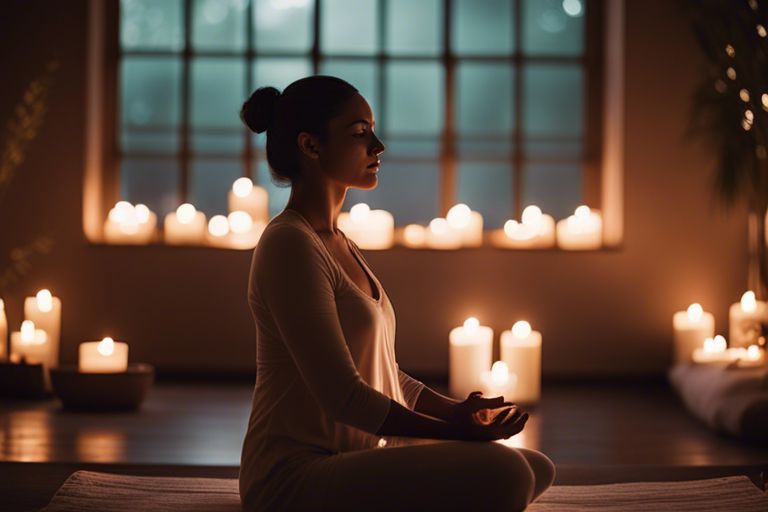You may have tried various relaxation techniques, but have you discovered the ultimate key to deep relaxation? Yoga Nidra meditation could be the answer you’ve been looking for. In this guide, find out how Yoga Nidra differs from traditional meditation techniques and learn how to incorporate it into your daily routine for maximum relaxation benefits. For more insights, check out Yoga Nidra Vs Meditation: Key Differences, Similarities & ….
Key Takeaways:
- Yoga Nidra Meditation: is a powerful meditation technique that induces deep relaxation by systematically relaxing different parts of the body.
- Benefits: include reduced stress, improved sleep, heightened self-awareness, and increased mind-body connection.
- Simple Practice: can be done lying down comfortably, making it accessible to individuals of all ages and abilities.
- Guided Sessions: are often available online or in-person, providing a structured format for those new to the practice.
- Regular Practice: can help individuals cultivate a sense of inner peace, enhance their overall well-being, and manage daily stress more effectively.
1. Find a quiet and comfortable space to lie down.
2. Close your eyes and focus on your breath.
3. Follow a guided meditation for total relaxation.
4. Let go of distractions and tensions in your body.
5. Practice visualization to calm the mind.
6. Experience deep relaxation and rejuvenation through Yoga Nidra.

Understanding Yoga Nidra Meditation
Before we probe into the benefits of Yoga Nidra meditation, it’s important to understand what this practice is all about.
What is Yoga Nidra Meditation?
Little is known about Yoga Nidra, also known as yogic sleep, It is a powerful meditation technique that allows you to reach a state of conscious relaxation between waking and sleeping. Unlike traditional meditation practices where you focus on your breath or a mantra, Yoga Nidra guides you through a series of body scans and visualizations to achieve a deep state of relaxation. This form of meditation is often practiced lying down, making it accessible to everyone, regardless of physical capabilities.
Types of Yoga Nidra Meditation
Even though Yoga Nidra is a single practice, there are different approaches and variations that you can explore based on your needs and preferences. Some of the types of Yoga Nidra meditation include Body Scan Nidra, Chakra Nidra, and Visualization Nidra. Each type focuses on different aspects of the mind and body, such as releasing tension from specific body parts or balancing the energy centers in the body.
- Body Scan Nidra: This type involves systematically scanning and relaxing each part of your body, from head to toe.
- Chakra Nidra: Focuses on balancing the energy centers in your body known as chakras through visualization and breathing techniques.
- Visualization Nidra: Involves guided imagery to help you relax and unwind, often incorporating nature scenes or peaceful settings.
After exploring these different types of Yoga Nidra meditation, you can find the one that resonates most with you to deepen your relaxation practice.
Preparing for Yoga Nidra Meditation
Clearly, creating the right environment is crucial for a successful Yoga Nidra meditation session. Here are some tips to help you set the stage for deep relaxation:
Tips for Creating a Conducive Environment
- Ensure your space is quiet and free from distractions.
- Dim the lights or use candles to create a calming atmosphere.
- Use comfortable props like pillows and blankets to support your body.
- Play soft music or nature sounds to enhance relaxation.
This will help you relax your body and mind, allowing you to fully immerse yourself in the practice.
Factors to Consider Before Starting Your Practice
- Choose a time when you won’t be interrupted for the duration of the practice.
- Wear loose and comfortable clothing to allow for easy movement and relaxation.
- Make sure you are neither too full nor too hungry before beginning your practice.
This will help you avoid distractions and fully focus on your meditation, perceiving the benefits more effectively.

A Step-by-Step Guide to Yoga Nidra Meditation
For Getting Started with Yoga Nidra, here is a simple step-by-step guide to help you begin your practice:
| 1. Find a comfortable and quiet space where you can lie down without being disturbed. | 2. Close your eyes and take a few deep breaths to relax your body and mind. |
| 3. Follow a guided Yoga Nidra meditation recording or use a script to lead yourself through the practice. | 4. Focus on your breath and body sensations as you move through the stages of relaxation. |
Deepening Your Relaxation
StepbyStep, as you progress in your Yoga Nidra practice, you can deepen your relaxation by focusing on releasing tension from different parts of your body. You can also set intentions or affirmations to promote positivity and well-being.
During the practice, you will enter a state of deep relaxation where your body and mind can fully unwind. This state of relaxation allows for healing, rejuvenation, and a sense of peace to wash over you.
Reaping the Benefits of Yoga Nidra
Yoga, the benefits of Yoga Nidra meditation extend beyond relaxation. Regular practice can help reduce stress, anxiety, and insomnia. It can also enhance self-awareness, creativity, and overall well-being.
To fully experience the benefits of Yoga Nidra, commit to a consistent practice and allow yourself to surrender to the process. You will notice improvements in your sleep, mood, and overall quality of life as you continue to engage with this powerful meditation technique.
Weighing the Pros and Cons of Yoga Nidra Meditation
Many practitioners of yoga and meditation are turning to Yoga Nidra as a method to achieve deep relaxation and self-discovery. As with any practice, there are both advantages and potential drawbacks to consider. Here, we will break down the pros and cons of Yoga Nidra meditation in detail.
The Advantages of Yoga Nidra Meditation
Weighing the pros of Yoga Nidra meditation, you will find that it offers a multitude of benefits. Firstly, it is a powerful tool for stress reduction and relaxation. By guiding you through different stages of consciousness, Yoga Nidra helps you release tension and achieve a deep state of calm. Additionally, it can improve your sleep quality by relaxing your mind and body before bedtime, leading to a more restful night’s sleep.
Potential Drawbacks to Consider
Yoga Nidra meditation, like any practice, also has its potential drawbacks that you should be aware of. One important point to consider is that you may experience emotional release during the practice. This can be intense at times and may bring up buried emotions or memories that you need to process. It is crucial to approach these experiences with self-compassion and seek support if needed.
For instance, if you are dealing with unresolved trauma or mental health issues, Yoga Nidra meditation could potentially trigger strong emotional responses that may be overwhelming. It is important to practice self-care and reach out to a mental health professional for guidance if you find yourself struggling with your emotions during the practice.
Conclusion
The practice of Yoga Nidra meditation can be a powerful tool for achieving deep relaxation and rejuvenation. By guiding you through a series of steps to relax your body and mind, Yoga Nidra helps you release tension, reduce stress, and improve your overall well-being. With regular practice, you may experience a profound sense of calmness and clarity that can positively impact your daily life.
The key to deep relaxation lies within you, and Yoga Nidra can help unlock that potential. By dedicating time to practice this meditation technique, you can cultivate a greater sense of awareness, peace, and connection with yourself. So, why not give it a try and see the transformative effects it can have on your mind, body, and spirit?
FAQ
Q: What is Yoga Nidra meditation?
A: Yoga Nidra is a form of guided meditation that is practiced while lying down in a comfortable position. It is designed to induce deep relaxation, reduce stress, and promote overall well-being.
Q: How does Yoga Nidra help in relaxation?
A: Yoga Nidra works by guiding you through different stages of relaxation, including body awareness, breath awareness, and visualization. This helps in calming the nervous system, reducing tension, and promoting a state of deep relaxation.
Q: What are the benefits of practicing Yoga Nidra meditation?
A: Some of the benefits of practicing Yoga Nidra meditation include improved sleep, reduced stress and anxiety, increased mindfulness, enhanced concentration, and a greater sense of overall well-being.











